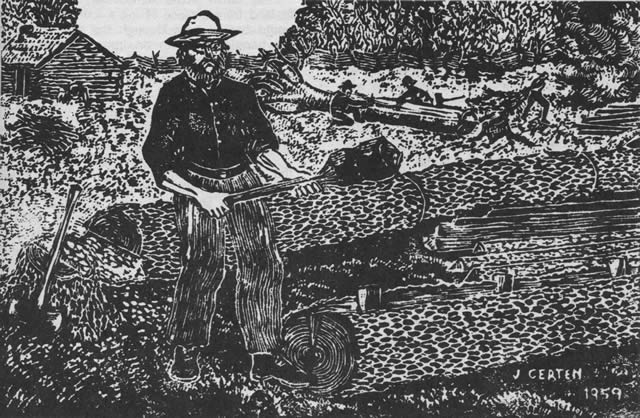Volume 2, Number 7 - Spring 1966
We Wield The Tools
by John Gerten

Spokane, Washington
In this day of power tools for every purpose I often think back to the times when tools were few and the power to wield them was furnished by ourselves and yet land was cleared and fenced and homes built at no great cost except a lot of hard labor.
For a couple just married the problem of getting settled in a home of their own was not as complicated as it is today as most of the material that went into the building of the house came from the clearing that surrounded it.
Logs, Shingles, Stones
The logs for the walls, the shingles for the roof, the stones for the fireplace and if there was a small saw mill not too far away, saw logs could be hauled there and sawn into rough timber to be used for floors, ceiling, doors and even furniture as was that in our home made by my father from this same kind of lumber from trees that were cut on the homestead.
Although this furniture was nothing fancy it was solid oak which is more than one can say today. And although the interior of these early day homes were about most "oak" furniture to plainly furnished and there were few articles one could call luxuries, still I believe people were more contented in these plain homes than many are today with all their modern labor saving devices and ways of entertainment.
Not Thought Yet
Most of these things were not even thought of at that time so were not missed.
The settlers who came still earlier, could even get along without a cook stove as bread could be
[5]
baked in a Dutch oven on the fireplace, so together with a cook pot, frying pan and coffee pot, they could cook a meal, but who could or would get by with this today.
When the homesteader had his logs all ready and the spot picked for his house which would generally be near a spring, the house would be raised with the help of his neighbors, who would come and make a day of it, the women preparing the dinner.
This system of helping one’s neighbor would also be used to get the Winter’s wood for old people that were feeble. It would be hauled to the house sawn up and split, ready for their use.
Tools Needed
The tools most needed by a home steader to clear his land and build his house were first an axe, a crosscut saw and a froe, a broad axe was also used if the logs for his house were hewed.
A handy tool when one must make an axe handle was a draw knife and a bit of glass if one had it to scrape the handle smooth with. Today, with all the window breaking, this would not be hard to get.
A "draw horse" was a wooden bench one sat straddle on and pressed against a foot pedal which clamped the axe handle tight so it could not slip while using the draw knife.
Most Useful Tool
I doubt if one can find many of them today if any, but the most useful tool of all which I think could be found at every home was a grindstone and of course, there must be a boy handy to turn it such as Benjamin was the time a man came by who had an "axe to grind." I have also done my share of turning the handle of a grindstone and so can sympathize with Benjamin.
In clearing land such trees as were fit for fence rails were cut into lengths and split. The tools required were few two or three iron wedges and several large wooden ones made with the help of an axe and a wooden maul, shaped out of a piece of tree trunk, and the handle was worked down with the axe until small enough to fit the hand.
My father would sometimes make a "beetle" instead from a piece of log a foot or so long. He would bore a hole through the side of this for the handle and with an iron ring from an old wagon hub on each end, but the maul served the purpose just as well and may have been easier to make.
Oak Rail Timber
Our rail timber on the upland was mostly post oak and was sometimes hard to split.
The early settlers who had first located in the choice bottom lands of Missouri, Indiana, Illinois, and other states, would hardly have bothered to split such small timber as this.
Many giant walnut trees were no doubt cut down and split into fence rails that in later years, would have been put to far better use. I have heard where walnut logs were burned to clear the land.
Perhaps rail splitting has almost become a lost art but there was one rail splitter who will always be remembered. His name was Abe Lincoln.
[6]
This volume: Next Article | Table of Contents | Other Issues
Other Volumes | Keyword Search | White River Valley Quarterly Home | Local History Home
Copyright © White River Valley Historical Quarterly

